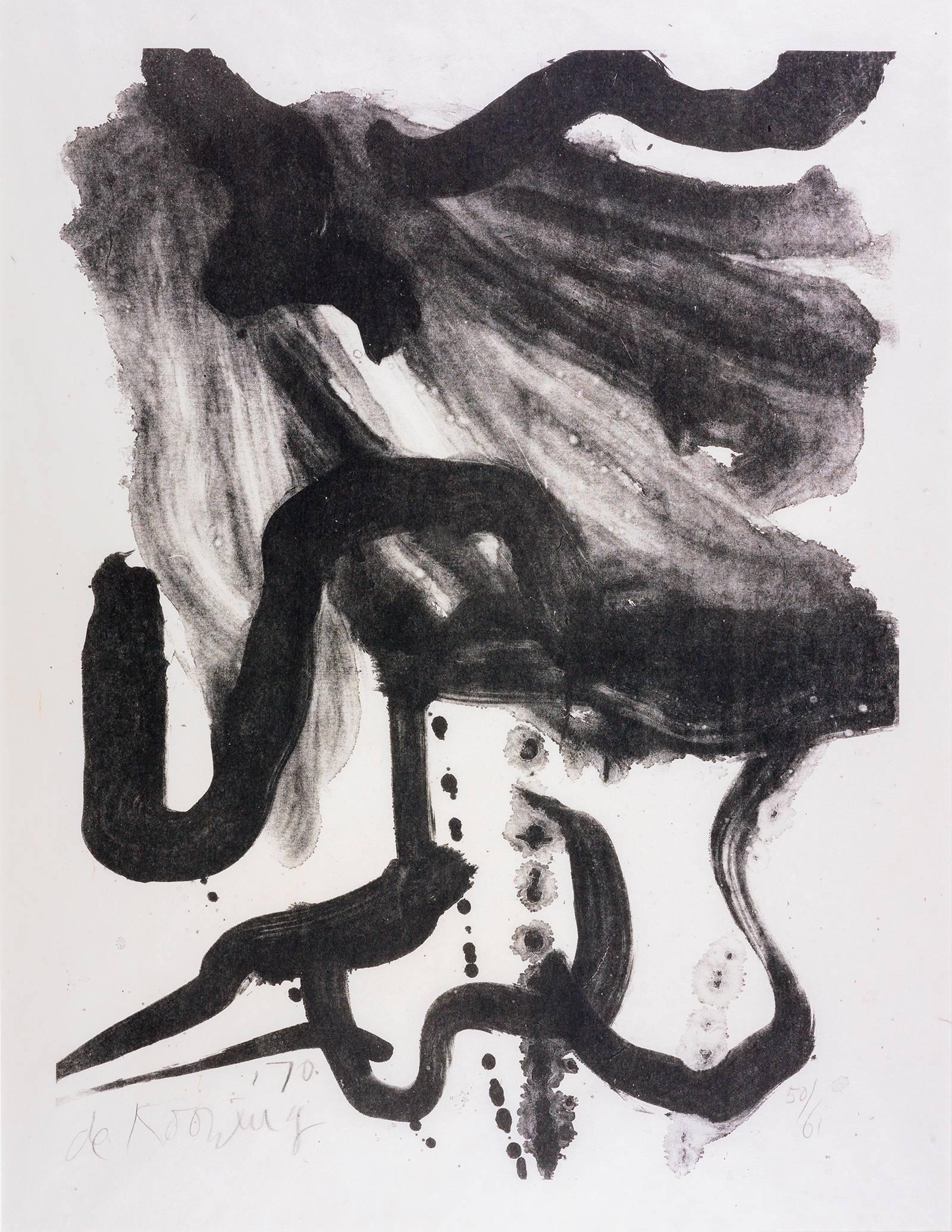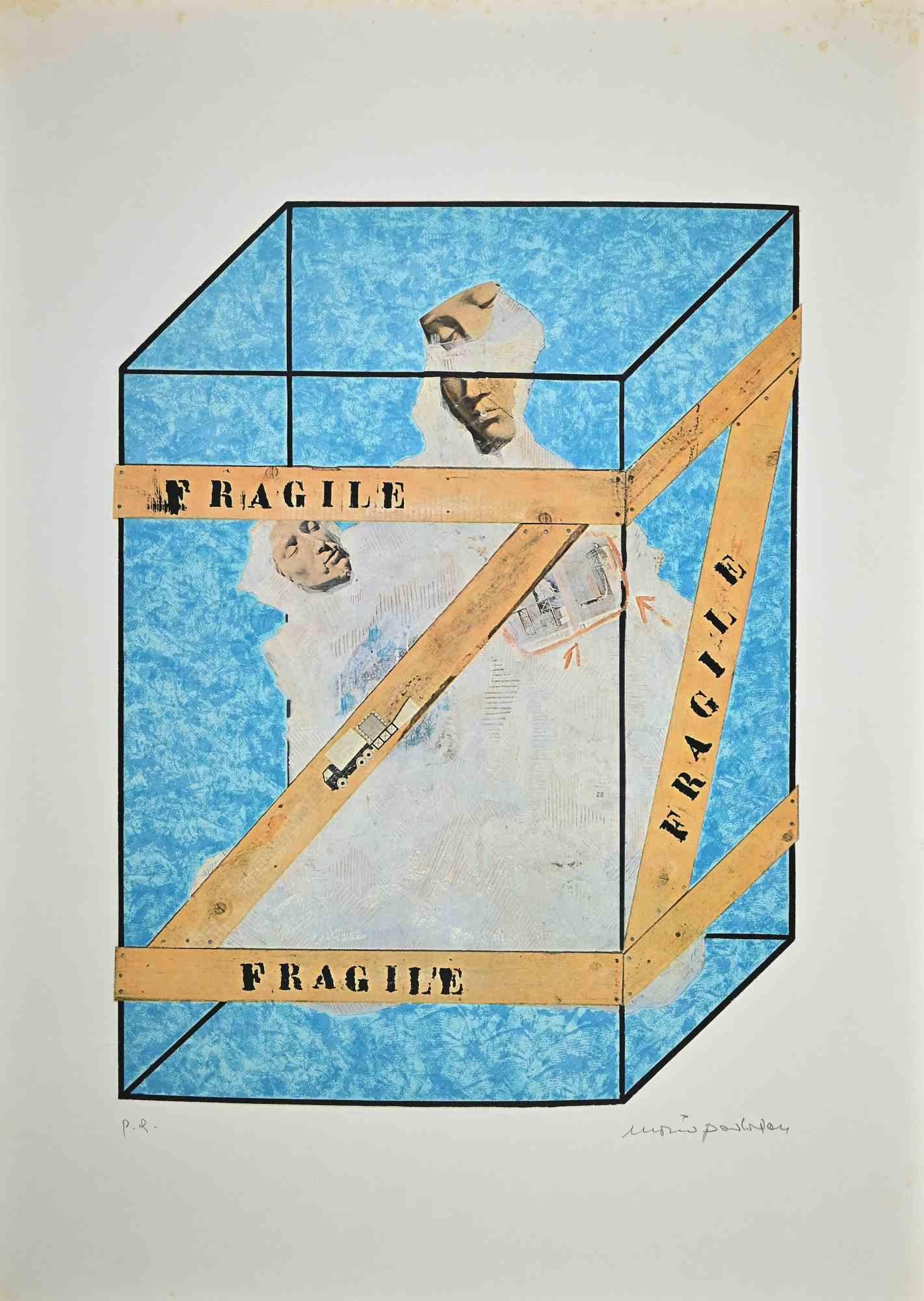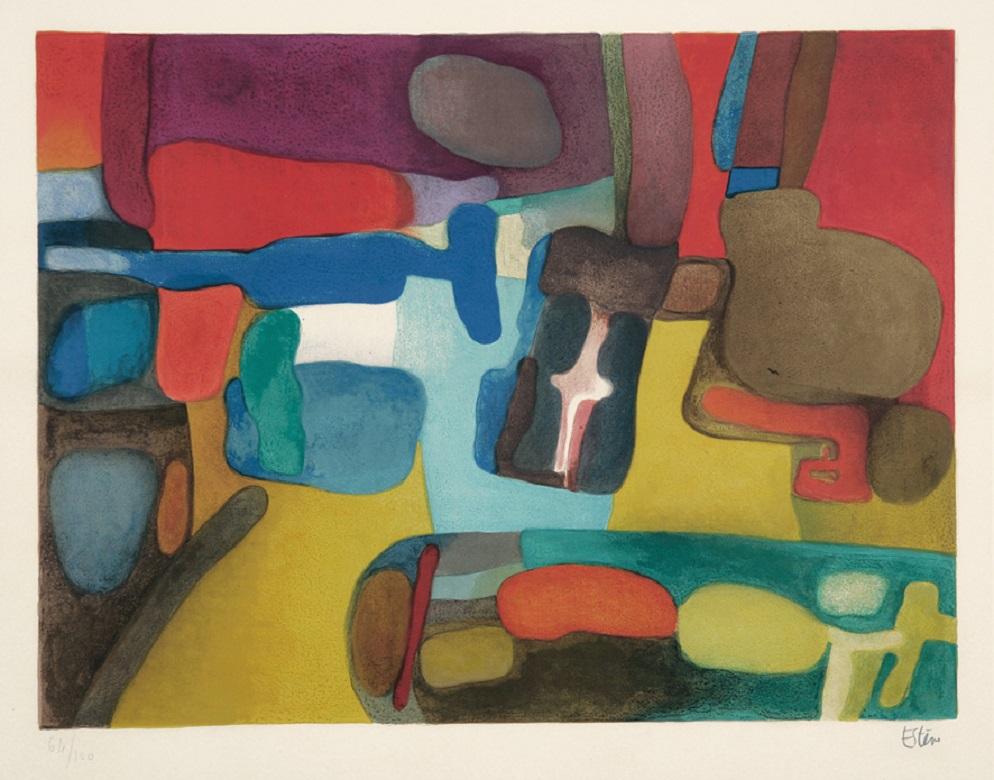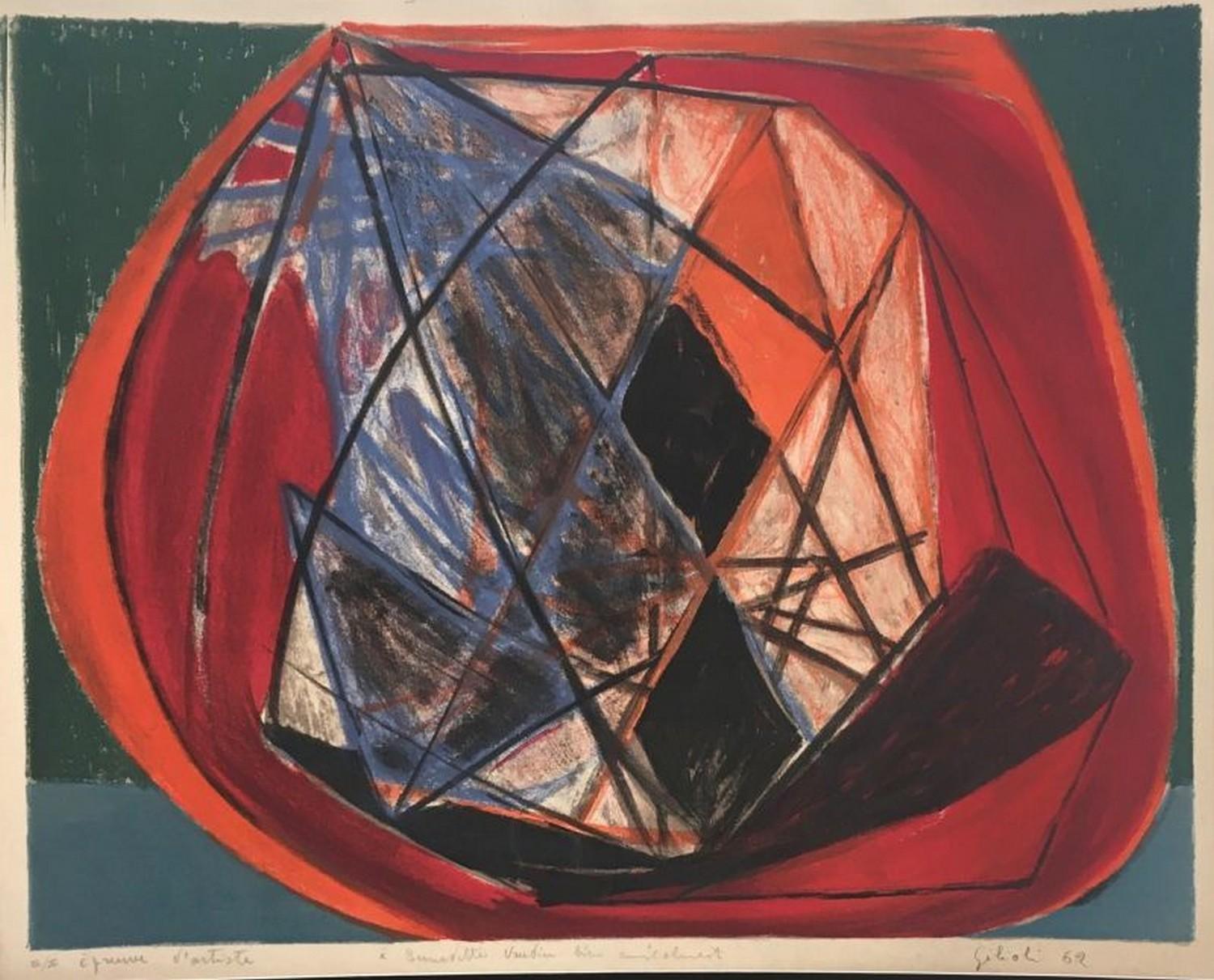Frank StellaUntitled1991
1991
About the Item
- Creator:Frank Stella (1936, American)
- Creation Year:1991
- Dimensions:Height: 23 in (58.42 cm)Width: 24 in (60.96 cm)
- Medium:
- Movement & Style:
- Period:
- Condition:One crease to the image, unobtrusive and supported by the support board.
- Gallery Location:Fairlawn, OH
- Reference Number:
Frank Stella
Frank Stella was one of the central figures in postwar American art. A proponent of minimalism and non-representational abstraction, Stella was a painter, printmaker and sculptor.
A native of Massachusetts, Stella attended Phillips Academy in Andover and earned a BA from Princeton, where he studied art and color theory with Josef Albers and Hans Hofmann. Stella frequented New York galleries as a student and was intrigued by the work of Jackson Pollock and Franz Kline, both of whom were at the height of their creative powers in the late 1950s.
After moving to New York in 1958, Stella gravitated toward the geometric abstraction and restrained painting style of Barnett Newman and Jasper Johns.
Johns’s flat, graphic images of common objects such as targets and flags prompt viewers to question the essential nature of representation and whether these pictures are really paintings or simply new iterations of the items themselves. Stella pushed Johns’s reasoning further, considering paintings on canvas as objects in their own right, like sculptures, rather than representations. This led him to reject certain formal conventions, eschewing sketches and often using nontraditional materials, like house paint.
In 1959, Stella created his “Black Paintings,” series, in which bands of black paint are separated by thin, precise stripes of bare canvas. At a time when contemporary painting was all about wild gestures, thick paint and formal abandon, these pieces created a sensation. That same year, Stella's work was included in the exhibition "Sixteen Americans" at the Museum of Modern Art in New York, and he joined the roster of artists represented by Leo Castelli Gallery. In 1960, he began introducing color into his work and using unconventionally shaped canvases to complement his compositions.
In his “Eccentric Polygon” series, from 1965 and ‘66, Stella embraces asymmetry and bold color, creating forms delineated by painted fields and by the edges of the canvas. This series was followed by the 1967–70 “Protractor” series, characterized by colorful circles and arcs. Named after the ancient cities whose circular plans Stella had noticed while traveling in the Middle East during the 1960s, these works usually comprised several canvases set flush against one another so that the geometric figures in each section came together in a larger, more complex whole.
Also in the mid-1960s, Stella started exploring printmaking, initially working with Kenneth Tyler, of Gemini G.E.L., and later installing printing equipment in his own studio. In 1968, he created the “V” series of lithographs, which included the print Quathlamba I. Following a solo exhibition at the Museum of Modern Art in 1970, Stella began working in three dimensions, adding relief elements to paintings, which could almost be considered wall-mounted sculptures.
Stella’s 1970–73 “Polish Village” series was inspired by documentary photos and architectural drawings of Polish synagogues that had been destroyed by Nazis during World War II. The resulting works — composed primarily of paint and cloth on plywood — are more rugged and less polished than his previous series.
Herman Melville's Moby Dick was Stella's muse for a series of three- dimensional works he created in the 1980s in which waveforms, architectural elements and Platonic solids play a prominent role. During this period, Stella embraced a new, exuberant style that is exemplified in "La Scienza della Fiacca."
In 1997, the artist oversaw the creation of the Stella Project, a 5,000-square-foot work inside the Moores Opera House at the University of Houston. A large free-standing sculpture by Stella stands outside the National Gallery of Art in Washington, D.C.
Stella’s work is in the collections of numerous important museums around the world, including New York’s Museum of Modern Art and Metropolitan Museum of Art; the Menil Collection, in Houston; the Hirshhorn Museum and Sculpture Garden, in Washington, D.C.; and the San Francisco Museum of Modern Art. He was awarded the National Medal of Arts by President Obama in 2009, and was given the Lifetime Achievement Award in Contemporary Sculpture by the International Sculpture Center in 2011.
Find original Frank Stella art for sale on 1stDibs.
- ShippingRetrieving quote...Ships From: Fairlawn, OH
- Return PolicyA return for this item may be initiated within 10 days of delivery.
- Red MountainBy Louisa ChaseLocated in Fairlawn, OHRed Mountain Three color lithograph, 1986-7 Signed, titled and dated in pencil lower right Annotated "B.A.T." for Bon a Tire lower left corner This example is the printers guide for printing the editon of 40 Printed on BFK Rives paper Printed at Derriere L'Etoile Studios, New York Printer: Maurice Sanchez Condition: Excellent, never framed Image/Sheet size: 45 1/4 x 30 inches Louisa Chase came to prominence in the 1980's as one of the outstandingNeo-Expressionist painters. Her work then was characterized by bold colors and brush strokes, often incorporating natural elements and fragments of the figure. Louisa Chase's works have been featured in gallery and museum shows in Cologne, Nurnberg, Luzem, Switzerland, Toronto, and Tokyo, and various galleries and museums throughout the US. She has also been featured at the American Pavillion at the 1984 Venice Biennale. Also in 1984, the Institute of Contemporary Art in Boston organized as travelling exhibition of her work. In 1997, the Madison Art Center organized a retrospective of her prints, Louisa Chase: Prints, 1981-1996. She has been a featured artist at the University of Wisconsin's Tandem Press and at the Tamarind Press; ahe was also invited to do a print for Lincoln Center in New York City. The recipient of two grants from the National Endowment for the Arts, Chase's works are in the permanent collections of such museum as The Museum of Modern Art, the Metropolitan Museum of Art, The Whitney Museum of American Art (New York), The Brooklyn Museum of Arts, The Corcoran Gallery and The Library of Congress (Washington D.C.), The Walker Art Center (Minneapolis), the Mount Holyoke College Art Museum, the Denver Museum of Art, and the Chazin Museum of Art of the University of Wisconsin, Madsion and the Madison Museum of Contemporary Art (Madison WI). Bibliography: Elizabeth Armstrong, Painters who print (Minnapolis: Walker Art Center, 1984); Ruth S...Category
1980s Abstract Expressionist Abstract Prints
MaterialsLithograph
- CalligraphyBy Ulfert WilkeLocated in Fairlawn, OHCalligraphy Lithograph, 1969 Edition: 260 Signed in script by the artist (see photo) Signed with initials and dated by the artist (see photo) Publication for the Print Club of Cleveland, No. 47 for 1969 Printer: Hollander Workshop, New York, with their chopstamp (see photo) Ulfert Wilke (1907–1987) was an internationally recognized painter, calligrapher and art collector connected to the abstract expressionism movement. He was born in Bavaria, Germany, and immigrated to the United States in 1938. He is best known for his large canvas paintings...Category
1960s Abstract Abstract Prints
MaterialsLithograph
- UntitledBy Walasse TingLocated in Fairlawn, OHUntitled Color lithograph, 1972 Unsigned Edition: From: Fresh Air School, Exhibition of Paintings Large Edition (2000?) Published by the Carnegie Institute Museum of Art, 1973 Printe...Category
1970s Abstract Abstract Prints
MaterialsLithograph
- Sprong in de Lente (Deux Personnages)By Karel AppelLocated in Fairlawn, OHSprong in de Lente (Deux Personnages) Color lithograph, 1963 Signed, dated and numbered in pencil (see photos) Edition: 25 Signed, dated and numbered in pencil Printed on Arches paper Probably exhibited at David Anderson Gallery/Martha Jackson Gallery. Provenance: Martha Jackson Gallery David Anderson Gallery David K. Anderson Grandchildren Trust Condition: Colors fresh and unfaded Slight oil stains verso from the ink, not visible on front Image size: 18 1/2 x 26 inches Sheet: 22 x 29 5/8 inches Karel Appel B. 1921, AMSTERDAM; D. 2006, ZURICH Karel Appel was born on April 25, 1921, in Amsterdam. From 1940 to 1943 he studied at the Rijksakademie van Beeldende Kunsten, Amsterdam. In 1946 his first solo show was held at Het Beerenhuis, Groningen, Netherlands, and he participated in Jonge Schilders (Young painters) at the Stedelijk Museum, Amsterdam. About this time, Appel was influenced first by Pablo Picasso and Henri Matisse, then by Jean Dubuffet. He was a member of the Nederlandse Experimentele Groep (Dutch Experimental Group, 1948) and established the Cobra group (1948–51) with Constant (Constant Nieuwenhuys), Corneille (Guillaume Cornelis Beverloo), and other painters from Copenhagen, Brussels, and Amsterdam. The style distinguished itself through bold, expressive compositions inspired by folk and children's art, as well as by the work of Paul Klee and Joan Miró. In 1949 Appel completed a fresco for the cafeteria of the city hall in Amsterdam, which created such controversy that it was covered for ten years. In 1950 the artist moved to Paris; there the writer Hugo Claus...Category
1960s Abstract Abstract Prints
MaterialsLithograph
- Drole de DrameBy Karel AppelLocated in Fairlawn, OHDrole de Drame Lithograph, 1960 Signed, dated and numbered in pencil lower right (see photos) Edition: 120 (91/120) Published by L’Ouevre Grave, Geneve (blindstamp recto) Printed by ...Category
1960s Abstract Abstract Prints
MaterialsLithograph
- UntitledBy Alexander CalderLocated in Fairlawn, OHUntitled Color lithograph, 1959 Unsigned (as issued) From: Derriere Le Miroir, No. 113, 1959 Publisher: Editions Pierre a Feu Editor: A. Maeght Small edition as it appeared in the ma...Category
1950s Abstract Abstract Prints
MaterialsLithograph
- Woman with Corset and Long HairBy Willem de KooningLocated in New York, NYPrinter: Hollanders Workshop, New York Publisher: Knoedler, New York Edition size: 61, plus proofs Catalogue Raisonné: Graham 17 Signed, dated, and numbered inpencil, lower marginCategory
1970s Abstract Expressionist Abstract Prints
MaterialsLithograph
- Fragile - Lithograph print by Mario Padovan - 1990sBy Mario PadovanLocated in Roma, ITFragile is an colored serigraph realized by Mario Padovan in the 1990s . Hand-signed in pencil on the lower right. Artist proof. Good conditions. This artwork represents a typica...Category
1970s Abstract Abstract Prints
MaterialsLithograph
- Cali - 20th Century, Maurice Estève, Abstract Print, Colourful, LithographBy Maurice EstèveLocated in Köln, DE"Cali" is a typical motif by Maurice Estève. The lithograph in colours was published in an edition of 100. 49,6 x 65 cm. Signed and numbered.Category
1960s Abstract Abstract Prints
MaterialsLithograph
- CompositionBy Émile GilioliLocated in Paris, FRLithograph, 1962 Edition : III/X 56.00 cm. x 76.00 cm. 22.05 in. x 29.92 in. (paper) 50.00 cm. x 63.00 cm. 19.69 in. x 24.8 in. (image) Annoted "Epreuve artiste" Handsigned by the ...Category
1960s Abstract Abstract Prints
MaterialsLithograph
- Composition abstraiteBy Alfred ManessierLocated in Paris, FRLithograph, 1975 Edition : V/XV 56.00 cm. x 76.00 cm. 22.05 in. x 29.92 in. (paper) 50.00 cm. x 67.00 cm. 19.69 in. x 26.38 in. (image) Lithograph belonging to a series of 15 litho...Category
1970s Abstract Abstract Prints
MaterialsLithograph
- Composition abstraiteBy Alfred ManessierLocated in Paris, FRLithograph, 1975 Edition : XI/XV 56.00 cm. x 76.00 cm. 22.05 in. x 29.92 in. (paper) 50.00 cm. x 67.00 cm. 19.69 in. x 26.38 in. (image) Lithograph belonging to a series of 15 lith...Category
1970s Abstract Abstract Prints
MaterialsLithograph
Recently Viewed
View AllRead More
Get to Know the Artists Who Led the Op Art Movement
In the 1960s and '70s, the hypnotic creations of Op artists went mainstream and influenced the look of pop culture.
Welcome (Back) to the Wild, Wonderful World of Walasse Ting
Americans are rediscovering the globe-trotting painter and poet, who was connected to all sorts of art movements across a long and varied career.






